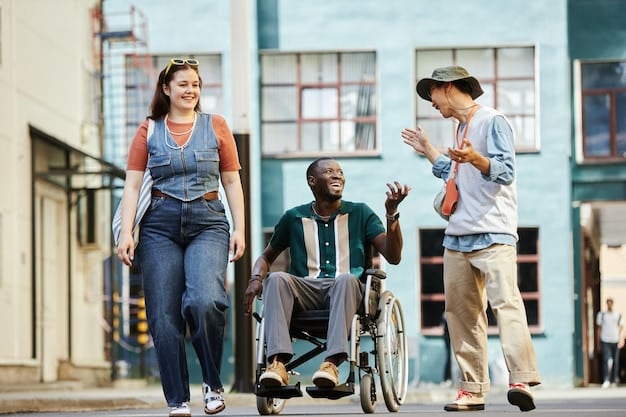Disability Rights in the US: Ensuring Equal Access & Opportunity

Disability rights in the US aim to guarantee equal access and opportunity for individuals with disabilities across various aspects of life, including employment, education, housing, and public accommodations, ensuring their full participation and inclusion in society.
Disability Rights in the US: How Can We Ensure Equal Access and Opportunity for All? is a critical question that demands consistent action and advocacy. This article explores the key aspects of disability rights, the challenges faced, and the strategies needed to build a more inclusive society.
Understanding Disability Rights in the US
Understanding disability rights in the US involves grasping the legal and social frameworks designed to protect individuals with disabilities. These rights are grounded in the principles of equality, inclusion, and non-discrimination, aiming to address historical and systemic barriers.
Key legislation and concepts form the foundation of disability rights in America:
The Americans with Disabilities Act (ADA)
The ADA, enacted in 1990, is a landmark civil rights law that prohibits discrimination based on disability. It covers various areas, including employment, public services, and accommodations.
Individuals with Disabilities Education Act (IDEA)
IDEA ensures that children with disabilities receive a free and appropriate public education (FAPE) tailored to their needs. This includes special education and related services.
Rehabilitation Act of 1973
The Rehabilitation Act prohibits discrimination based on disability in programs conducted by federal agencies, receiving federal financial assistance, or in federal employment.
These laws, along with state and local regulations, create a comprehensive framework aimed at ensuring that people with disabilities have the same rights and opportunities as everyone else. However, awareness and enforcement remain critical to achieving true equality.

Challenges in Ensuring Equal Access
Despite the legal protections in place, people with disabilities continue to face significant challenges in accessing equal opportunities. These challenges span various sectors and highlight the persistent gaps in implementing disability rights.
Several key barriers impede full inclusion:
- Physical Accessibility: Many buildings, transportation systems, and public spaces remain inaccessible to individuals with mobility impairments.
- Employment Discrimination: People with disabilities often face discrimination in hiring, promotion, and workplace accommodations, leading to high unemployment rates.
- Educational Barriers: Inadequate resources and support in schools can hinder the educational progress of students with disabilities.
- Healthcare Disparities: Limited access to affordable and quality healthcare services can negatively impact the health and well-being of individuals with disabilities.
Overcoming these challenges requires a multi-faceted approach involving policy changes, increased awareness, and proactive measures to ensure accessibility and inclusion in all aspects of life. Addressing these barriers is essential for realizing the promise of equal rights for people with disabilities.
Strategies for Promoting Disability Rights
Promoting disability rights requires proactive strategies that address systemic barriers and foster inclusive environments. These strategies involve a combination of advocacy, policy changes, and community engagement.
Effective measures for advancing disability rights include:
Advocacy and Awareness Campaigns
Raising public awareness about disability issues and advocating for policy changes are crucial steps in promoting disability rights. Grassroots movements and advocacy organizations play a vital role in shaping public opinion and influencing legislation.
Inclusive Design and Accessibility Standards
Implementing universal design principles in architecture, technology, and public services can create more accessible environments for everyone. Accessibility standards should be enforced and continuously updated to reflect evolving needs and technologies.
Employment and Education Support Programs
Providing targeted support programs that assist people with disabilities in finding and maintaining employment, as well as accessing quality education, can significantly improve their opportunities. These programs should focus on skills training, job placement, and reasonable accommodations.
Ensuring equal access and opportunity requires ongoing efforts and a commitment from individuals, organizations, and government agencies to create a more inclusive society for all.

The Role of Technology in Advancing Disability Rights
Technology plays a pivotal role in advancing disability rights by providing tools and solutions that enhance accessibility, communication, and independence. Assistive technologies and digital platforms can help bridge gaps and empower individuals with disabilities.
Key aspects of technology in promoting disability rights include:
- Assistive Devices: Devices like screen readers, mobility aids, and hearing aids enable people with disabilities to overcome physical and sensory barriers.
- Digital Accessibility: Ensuring that websites, online content, and software are accessible to users with disabilities is essential for equal access to information and services.
- Telehealth: Telehealth services can improve access to healthcare for individuals with disabilities, particularly those in rural or underserved areas.
- Communication Tools: Communication apps and devices facilitate interaction and expression for individuals with speech or communication impairments.
Investing in and promoting the development and adoption of assistive technologies can significantly improve the quality of life and opportunities for people with disabilities. By leveraging technological advancements, we can create a more inclusive and accessible world.
Legal Frameworks and Disability Rights
Legal frameworks are essential for protecting and promoting disability rights in the US. These frameworks provide a legal basis for challenging discrimination and ensuring equal access to opportunities.
Among the key legal provisions are:
Enforcement of ADA and Rehabilitation Act
Vigorous enforcement of the ADA and the Rehabilitation Act is crucial for ensuring compliance and addressing instances of discrimination. Legal action and regulatory oversight can hold entities accountable for violating disability rights.
Strengthening IDEA for Inclusive Education
Enhancing the implementation of IDEA can improve educational outcomes for students with disabilities. This includes providing adequate funding, resources, and training for educators to support inclusive education practices.
Advocating for State and Local Disability Rights Laws
Supporting the enactment and enforcement of state and local disability rights laws can provide additional protections and remedies for individuals with disabilities at the community level. These laws can address specific needs and challenges unique to different regions.
By strengthening and enforcing legal frameworks, we can create a more just and equitable society where disability rights are respected and upheld.
Community Support and Inclusion
Community support and inclusion are vital for fostering a sense of belonging and empowerment among people with disabilities. Creating inclusive communities requires intentional efforts to break down barriers and promote social interaction.
Effective community-based strategies include:
- Inclusive Community Programs: Offering recreational, social, and cultural programs that are accessible and welcoming to people with disabilities can promote social inclusion and participation.
- Support Networks: Establishing peer support groups and mentoring programs can provide individuals with disabilities with valuable emotional support and guidance.
- Accessibility Audits: Conducting accessibility audits of public spaces and community facilities can identify and address barriers to access.
By fostering inclusive communities, we can create environments where people with disabilities are valued, respected, and fully integrated into society.
| Key Point | Brief Description |
|---|---|
| ♿ ADA Enforcement | Ensuring compliance with ADA to eliminate disability discrimination. |
| 🧑🏫 Inclusive Education | Promoting inclusive education for students with disabilities through IDEA. |
| 📱 Assistive Technology | Leveraging technology to enhance accessibility and independence. |
| 🤝 Community Support | Fostering inclusive communities and support networks for all. |
Frequently Asked Questions (FAQ)
▼
The ADA is a civil rights law that prohibits discrimination based on disability. It ensures equal opportunities in employment, public services, and accommodations, protecting individuals from unfair treatment due to their disability.
▼
IDEA ensures that children with disabilities receive a free and appropriate public education (FAPE) tailored to their needs, including special education and related services to help them succeed academically and socially.
▼
Common challenges include physical accessibility barriers, employment discrimination, educational obstacles, and healthcare disparities, all of which hinder their full participation in society despite existing legal protections.
▼
Technology advances disability rights by providing assistive devices, ensuring digital accessibility, offering telehealth services, and facilitating communication, thereby enhancing independence and access to information and services.
▼
Community support fosters a sense of belonging by creating inclusive programs, establishing support networks, and ensuring accessibility, enabling people with disabilities to be valued and fully integrated into society.
Conclusion
Ensuring disability rights in the US: how can we ensure equal access and opportunity for all? requires a multifaceted approach involving legal frameworks, technological advancements, and community support. By addressing these challenges head-on, we can create a more inclusive and equitable society where everyone can thrive.





